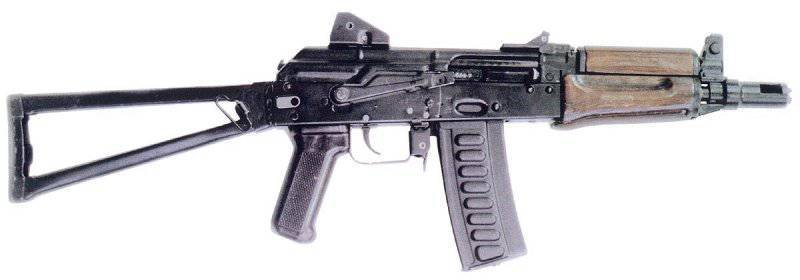Small-sized machine "Tiss"
Along with the work in TsNIITochmash and KBP, new weapons were created in the Tula TsKIB SOO. Shortly before the collapse of the Soviet Union, there was already developed a weapons complex for the OTs-Xnumx "Thunderstorm" special forces, created under the ammunition of the SP-14 and SP-5. Designers V. Telesh and Yu. Lebedev made the “Thunderstorm” on the basis of the AKS6U assault rifle, and the shortened Kalashnikov was also chosen as the base design for the new assault rifle. It should be noted that with a large degree of unification of the “Thunderstorm” and “Ksyusha” their designs significantly differed both in the general layout and in a number of some details. They decided to make the new machine, which received the internal designation OC-74, and then the nickname "Tiss", structurally more similar to the original AKS12U.
As a result of all the work in the 1992-93 years began shooting tests of the new machine. In accordance with the chosen concept of maximum unification, even outwardly, “Tiss” differed little from the basic model. The "internals" were also slightly redone. From AKS74U left automatic with a vapor engine. The barrel is locked by turning the bolt. The latter has a larger cup size compared to the Kalashnikov and is similar to the thunderbolt shutter. Also "Tiss" has a trunk of the appropriate caliber (9 mm) and a muzzle of a new design, still playing the role of an expansion chamber, but modified to use the new cartridge. The power supply of OTs-12 is carried out from box magazines for 20 cartridges created in due time for OTs-14. The trigger mechanism "Kalashnikov" was borrowed without any changes. Accordingly, the principle of operation of the fuse-translator of fire remained the same. The folding butt, sights, handguards, and others. Transferred to the “Tissu” from AKS74U almost unchanged, although the underside of the forearm slightly changed shape, and the scope was remade to fit the ballistics of the new cartridge.
According to the results, the OTs-12 differs from the “prototype” only in some figures: the trunk of the Tula machine gun is shorter (200 mm versus 210 mm), with the butt “Tiss” spread out also shorter by 5 mm (730 versus 735) and lighter by about 200 grams . OC-12's rate of fire is higher than that of the shortened Kalashnikov, and is 800 rounds per minute.
Special success "Tissu" to achieve and failed. With cheap manufacturing, he could not compete normally with 9А91 or "Whirlwind", which was developed as part of the complexes. As a result, until the mid-90-x was released some amount of OTs-12. It is rather difficult to establish their exact number: in some sources it is said about several units, in others - about several hundred. The situation is similar with application information. Whether the "Tiss" managed to visit only the site, or was operated in the special units of the Ministry of Internal Affairs. However, regardless of the “biography” of the machine gun, he did not go into a large series and remained an experimental weapon.

Information